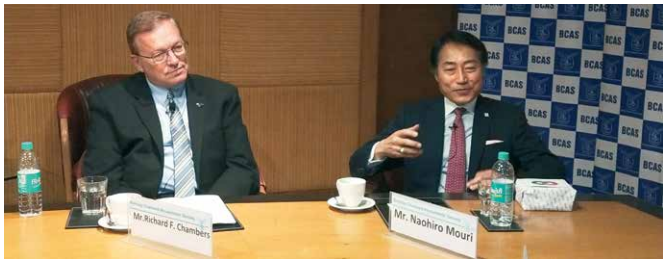78. ACIT vs. Bennett Property Holdings Company Limited
ITA No. 556/Mum./2024
A.Y.: 2017-18
Date of order: 12th December, 2024
Section: CBDT Circular No. 5 of 2024 dtd. 15th March, 2024 r.w. Circular No. 9 of 2024 dtd 17th September, 2024
For the purpose of computing the ‘tax effect’, in the present case, only the grounds raised by the Revenue having an impact of determination of total income under the normal provisions of the Act ought to be considered for the reason that the Assessee would continue to be assessed under normal provisions of the Act even if all the grounds raised by the Revenue in departmental appeal are assumed to be allowed in favour of the Revenue.
FACTS
For AY 2017-18, the Assessee company, primarily engaged in the business of earning rental income by letting out properties and running business centres, filed original return of income which was subsequently revised. The Assessing Officer (AO), in an order passed under section 143(3), assessed the total income of the Assessee under the normal provisions of the Act at ₹1,20,45,17,348/- and computed Book Profits of the Assessee under Section 115JB of theAct at ₹1,33,19,94,660/-. Since the tax payable on Book Profits was less than the tax payable on the income computed under normal provisions of the Act, the Assessee was assessed to tax under normal provisions of the Act.
Aggrieved by the additions made by the AO while assessing the total income, the assessee preferred an appeal to CIT(A) challenging certain additions / disallowances made under normal provisions of the Act viz. (i) disallowance of ₹6,38,05,371/- under Section 14A of the Act; (ii) addition taking deemed annual letting value of the immovable properties lying vacant during the relevant previous year at ₹23,28,000; and (iii) denial of claim of set off of accumulated loss of ₹12,86,53,730 and unabsorbed depreciation of ₹15,65,15,799 relatable to real estate service undertaking of Banhem Estates & IT Parks Ltd. That demerged into the Assessee pursuant to composite scheme of amalgamation and arrangement approved by the Hon’ble Bombay High Court vide order, dated 2nd December, 2016.
The assessee also challenged the following additions made by the AO while computing the amount of book profits u/s 115JB viz. (i) increase in Book Profits by Extra Depreciation of ₹4,38,18,551; (ii) increase in Book Profits by ₹6,38,05,371 disallowed under Section 14A of the Act by invoking provisions contained in Clause (f) of Explanation 1 to Section 115JB of the Act; and (iii) rejection of Assessee’s claim of substitution of long-term capital gain (computed by taking index cost of acquisition) in place of the profit on sale of capital asset appearing in the statement of Profit & Loss Account for the purpose of computing Book Profits.
The assessee also raised additional grounds seeking credit for TDS in respect of companies / undertakings forming part of composite scheme and also challenged computation of interest under section 234B of the Act.
The appeal preferred by the Assessee was disposed off by the CIT(A)as partly allowed vide order, dated 13th December, 2023. The CIT(A) granted partial relief by (a) deleting the addition made under normal provisions of the Act in respect in respect of deemed rental income estimated at ₹23,28,000/-, and (b) accepting Assessee’s contention that no disallowance of expenses can be made in respect of any exempt income by invoking provisions contained in Section14A read with Rule 8D of the IT Rules while computing Book Profits under Section 115JB of the Act.
Since, both, the Assessee as well as the Revenue were aggrieved by the order passed by the CIT(A), the present cross-appeals were preferred before the Tribunal.
Before the Tribunal, on behalf of the assessee, it was submitted that the Assessee has been assessed under normal provisions of the Act. Even if the grounds raised by the Revenue in relation to the computation of ‘Book Profits’ under Section 115JB of the Act are allowed in favour of the Revenue, the Assessee would be assessed to tax under the normal provisions of the Act. It was submitted that the grounds of appeal raised by the Revenue pertaining to the additions / disallowance made under the normal provisions of the Act carry tax effect below the specified monetary of ₹60 Lacs fixed by Central Board of Direct Taxes(CBDT) for filing Departmental Appeal before the Tribunal limit. Therefore, the appeal preferred by the Revenue should be dismissed as withdrawn in view of Circular No. 5 of 2024, dated 15th March, 2024, read with Circular No. 9 of 2024, dated 17th September, 2024, issued by CBDT.
HELD
The Tribunal noted that the Revenue has preferred appeal challenging the deletion of addition in respect of deemed annual letting income of ₹23,28,000 under normal provisions of the Act. The Revenue has also challenged the relief granted by the CIT(A) by accepting Assessee’s claim that the ‘Book Profits’ could not be increased by ₹6,38,05,371 (being amount disallowed under Section 14A of the Act read with Rule 8D of the IT Rules), by invoking provisions contained in clause (f) of Explanation 1 to Section 115JB of the Act. Thus, the Tribunal observed that Revenue has raised grounds having impact on the computation of income under normal provisions of the Act and the computation of ‘Book Profits’ under Section 115JB of the Act.
The Tribunal perused the Circular No. 5 & 9 of 2024 issued by the CBDT and held that Circular No.5 of 2024, dated 15th March, 2024, when read with Circular No.9 of 2024, dated 17th September, 2024, issued by CBDT clarifies that the monetary limit of ‘tax effect’ for filing departmental appeals before Tribunal has been increased from ₹50 Lakhs to ₹60 Lakhs. It has also been clarified in Circular No. 9 of 2024 that the aforesaid monetary limit for filing the appeal before the Tribunal would also apply to the pending departmental appeals.
The Tribunal held that for the purpose of computing the ‘tax effect’ involved in the present appeal preferred by the Revenue only the grounds raised by the Revenue having an impact of determination of total income under the normal provisions of the Act ought to be considered. This is because the Assessee has been assessed under the normal provisions of the Act and this would continue to be the case even if all the grounds raised by the Revenue (whether related to computation of income under normal provisions of the Act or related to computation of Book Profits under 115JB of the Act) are allowed.
On examination the grounds raised by the Revenue having impact on computation of income under normal provisions of the Act, the Tribunal found that tax effect involved in the present appeal is below the monetary limit of Rs.60 Lakhs fixed by the CBDT for the purpose of filing departmental appeal before the Tribunal.
On perusal of Para 5.1 of Circular No. 5 of 2024 containing the definition of `tax effect’, the Tribunal observed that ‘tax effect’ has been defined to mean the tax on the total income assessed and the tax that would have been chargeable had such total income been reduced by the amount of income in respect of the issues against which appeal is intended to be filed. It held that when computed as aforesaid, the tax effect in the appeal preferred by the Revenue would fall below the specified monetary limit of ₹60 Lakhs for filing departmental appeals. On perusal of the computation submitted by the Assessee the Tribunal found that the tax effect in the appeal preferred by the Revenue would only be ₹5,63,973 for the reason that the Assessee would continue to be assessed under normal provisions of the Act even if all the grounds raised by the Revenue in departmental appeal are assumed to be allowed in favour of the Revenue. Thus, accepting the contention of the Assessee, we dismiss the appeal preferred by the Revenue as ‘withdrawn’ in terms of Circular No.5 & 9 of 2024 issued by CBDT.









